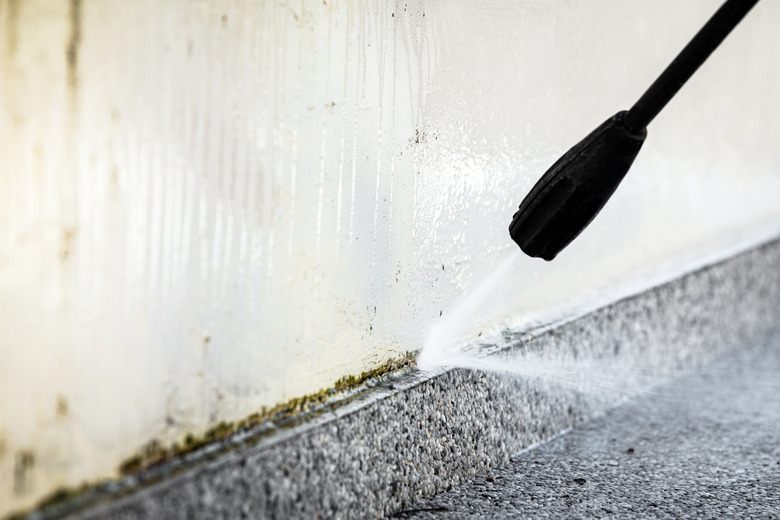How To Kill Black Mold On Concrete
We may receive a commission on purchases made from links.
Black mold is a serious health hazard and can be caused by even the most inconspicuous of leaks, like a pinhole in a water radiator, and it worsens considerably with time. Often, the mold you see has been in the making for weeks, months, or years, so the sooner you confront it, the better. The trouble with black mold is that it's the cosmetic sign of something else you need to solve: a moisture problem that's encouraging mold growth. Removing mold isn't that hard, but keeping it abated is another matter.
Things Needed
-
Respirator mask
-
Full-coverage clothing and a hat
-
Disposable gloves
-
Tarps (if necessary)
-
Spray bottle or lawn-and-garden sprayer
-
Mold or mildew cleaner (optional but recommended)
-
Stiff-bristle brush
-
Water hose or bucket
-
Mop (optional)
-
Towels (optional)
-
Borax (optional)
-
Bleach (optional)
How to Remove Mold From Concrete
How to Remove Mold From Concrete
Any mold-affected areas larger than 10 square feet should not be cleaned by homeowners, the reason being the toxicity of mold and the complexity of such a large mold problem. Mold is a difficult problem to mitigate anyhow because it's so dependent on you fixing the environment that is creating it. Maybe your basement foundation is cracked, maybe there's a failing pipe joint in the wall, or maybe the weeping tile around the home perimeter wasn't installed correctly — but without resolving the source, the mold will return. Outdoors, all you can do is clean it, not control it.
1. Find the Source and Deal With It
It's easier said than done since even a pinhole can create extensive issues if it's not found for months or years. Renters are often at the mercy of landlords, so there's only so much that can be done, but if you can find the source and document it, it may help you to get the problem resolved. Steps you will need to take depend entirely on what the source is.
2. Get Protected
If you're ready to work, be sure you're covered from head to toe, as you don't want mold spores in your hair or elsewhere on your body. This means a respirator mask, eye protection, full-coverage clothing, a hat or hair covering, and disposable gloves, which you should discard every time you stop work. Next if you're working in the basement, turn off all heat and air systems so the air won't circulate while you mitigate mold. If you're working on concrete outdoors, that's obviously not an issue, but not working on a windy day is wise.
3. Prepare the Area
If you're working outdoors, cover nearby foliage with tarps to protect it. Whether you're working on concrete walls or floors or on pavers outdoors, the mold should be sprayed with water thoroughly — or the cleaner you have chosen — before you start so that it's wet and will not become airborne. Ideally, you'll use a fungicide or mold/mildew remover. Either way, saturate the area and let it sit for about 30 minutes. For smaller areas, a spray bottle will do, but for large outdoor areas, a lawn and garden sprayer will speed things up.
4. Clean the Area
Lightly spray on more solution and then scrub the black mold from the concrete with a stiff-bristle scrub brush. Avoid using a wire-bristle brush, which can damage concrete. (There can be stains on concrete from mold; this is not unusual. It may improve with use of mildew stain removers, but staining is typical and does not mean the mold will return.)
5. Rinse and Allow to Dry
Thoroughly rinse the area with water to banish mold spores. Outdoors, you can use a garden hose. Indoors, you'll need a bucket of clean water for rinsing. Towels may help sop up some moisture to speed the drying process indoors, but allow the treated area to dry thoroughly once cleaned and rinsed.
6. Prevent Future Mold
Contractors and some homeowners swear by borax as a mold preventer once the cleaning job is finished. It's apparently quite good at cleaning mold, but it is also a deterrent. Once you've cleaned, rinsed, and dried the affected area, spray a solution of borax on it and simply walk away, as borax does not need to be rinsed. Simply dissolve 1 cup of borax in a gallon of water and use that as your solution. Bleach is a popular option, but should be used with caution, as explained below.
About Bleach and Paint
About Bleach and Paint
Bleach is famously effective at cleaning away mold. The only issue when using bleach with concrete is that it can affect concrete sealants. Outdoors, it can kill foliage. Still, a well-diluted bleach solution, roughly 3/4 cup per gallon, is great at killing mold on concrete. After rinsing in step 5, you can wet-mop a solution onto concrete, allow it to sit 30 minutes, rinse, and proceed with drying or applying a preventive coat of borax. Always rinse thoroughly before and after bleach, as it's hazardous to mix with other products.
Finally, never paint previously moldy concrete, as any returning mold will be trapped under the paint and will fester.
